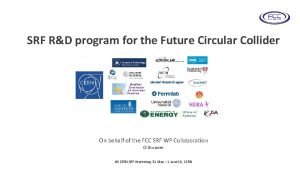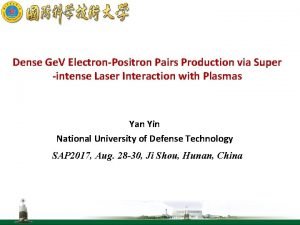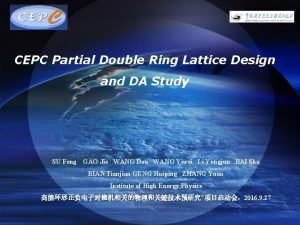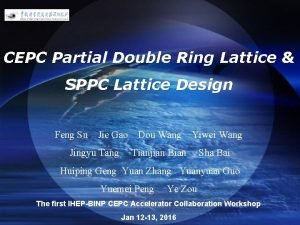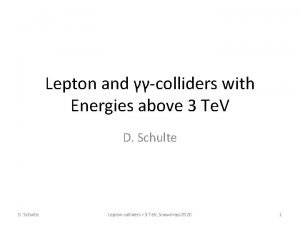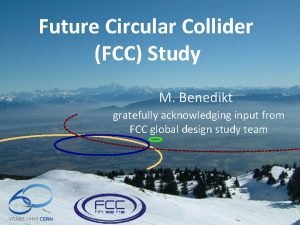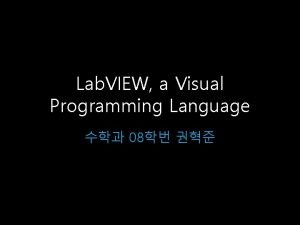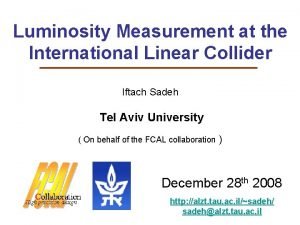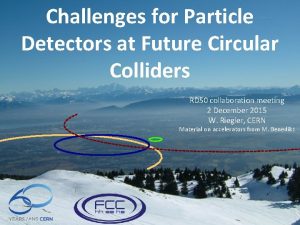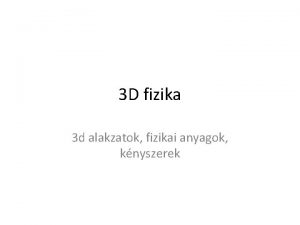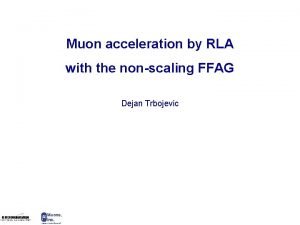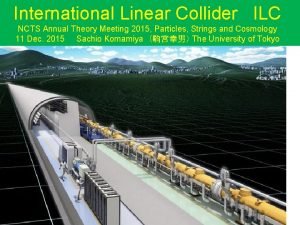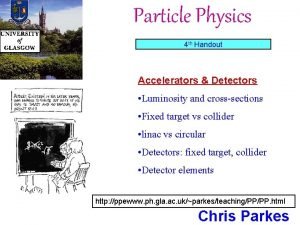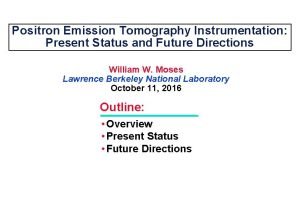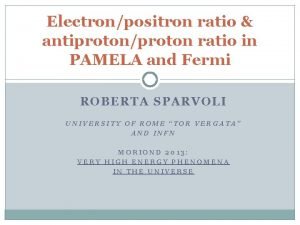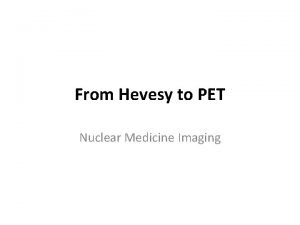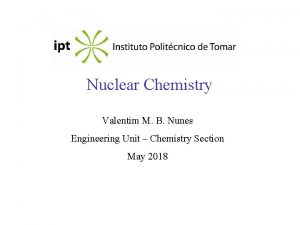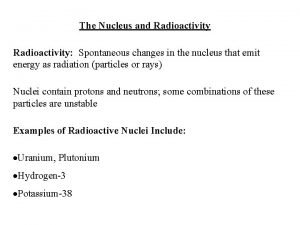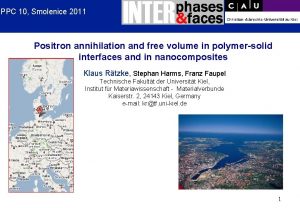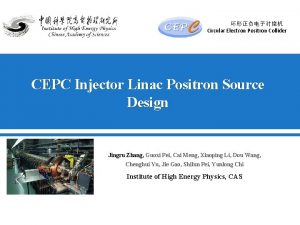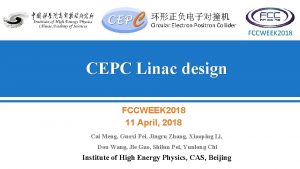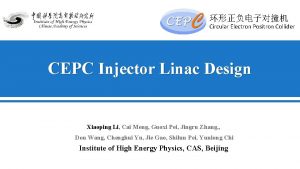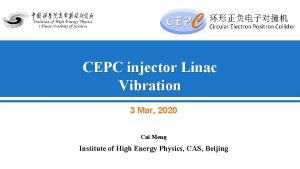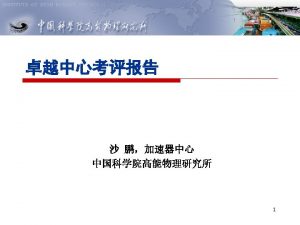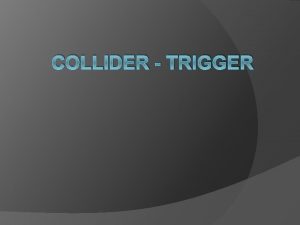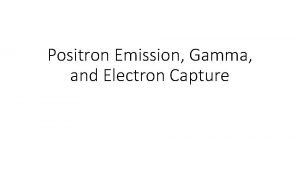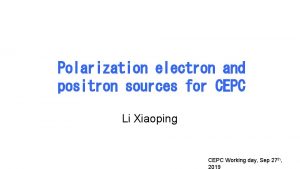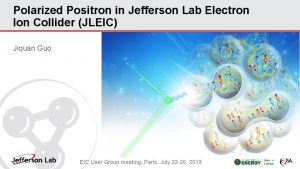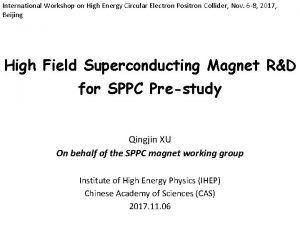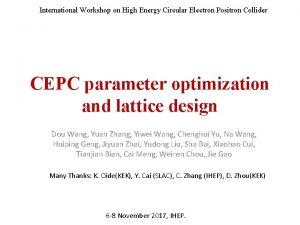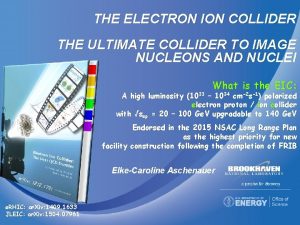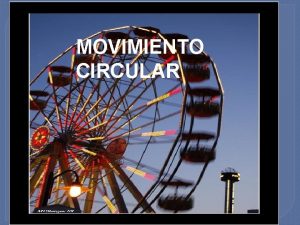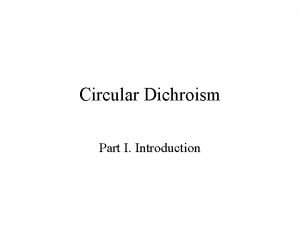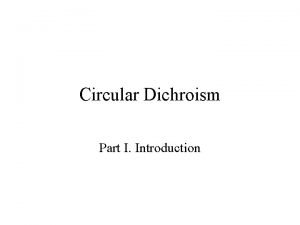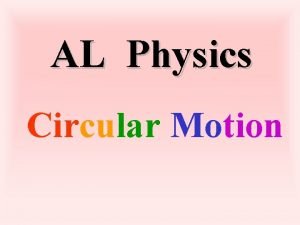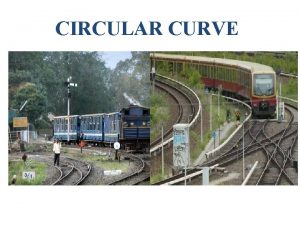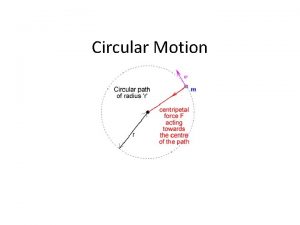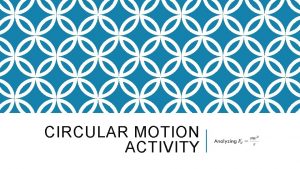Overview of the Circular Electron Positron Collider CEPC





















- Slides: 21

Overview of the Circular Electron Positron Collider (CEPC) design Chenghui Yu for the CEPC accelerator team June 24, 2020

Outline • Physics goals of CEPC • Overview of the facility • Machine introduction Collider ring Booster Linac • Key beam physics challenges • Summary

Physics goals of CEPC Precision measurement e+e- Higgs & Z factory Ecm 240 Ge. V, luminosity/IP 3 1034 cm-2 s-1, 2 IPs, >1 M Higgs in 10 years Ecm 91 Ge. V, luminosity/IP > 1 1034 cm-2 s-1, 2 IPs, 1010 Z /year Precision measurement of the Higgs boson and the Z boson Higgs precision 1% or better Potential for beam energy upgrade enough magnet length space in ARC and long enough straight section in RF region BEPCII has already operated for 12 years CEPC – possible accelerator based particle physics program in China after BEPCII

Beam Energy Ge. V 120 Peak Luminosity (10^34)/IP cm-2 s-1 3. 0 Int. Luminosity ab-1/year 1. 4 Beam d. E/E at IP 0. 00134 Transv. Beam sizes at IP x/y um 20. 9 / 0. 06 Rms bunch length / beta. Y* mm 4. 4 / 1. 5 Crossing angle mrad 33 Rep. /Rev. frequency Hz 3000 Bunch spacing ns 680 # of IPs 2 # of bunches 242 Length/Circumference km 100 Facility site power MW 300 Cost range $B US 5. 0 Timescale till operations 2030 Overview of the facility

CEPC Timeline (preliminary and ideal) Current time CEPC Pre-studies (2013 -2015) R&D Engineering Design (2016 -2022) Construction (2022 -2030) Data taking (2030 -2040) 1 st Milestone: Pre-CDR (by the end of 2014) ; 2 nd Milestone: R&D funding from MOST (in Mid 2016); 3 rd Milestone: CEPC CDR progress Report (by the end of 2016); 4 th Milestone: CEPC CDR Report (by the end of Aug 2018); 5 th Milestone: CEPC TDR Report and Proto R&D (by the end of 2022); 6 th Milestone: CEPC construction start (2022);

ar. Xiv: 1809. 00285 CEPC accelerator CDR completed in June 2018 1. Introduction 2. Machine Layout and Performance 3. Operation Scenarios 4. CEPC Collider 5. CEPC Booster 6. CEPC Linac 7. Systems Common to the CEPC Linac, Booster and Collider 8. Super Proton Collider 9. Conventional Facilities 10. Environment, Health and Safety 11. R&D Program 12. Project Plan, Cost and Schedule CDR International Review June 28 -30, 2018. Final CDR (accelerator) released on Sept. 2, 2018

Candidate sites of CEPC

Machine introduction • Double ring collider with 2 IPs • Compatible with the geometry of SPPC

Machine introduction • CEPC which aims at researching Higgs boson is a double ring scheme optimized at the beam energy of 120 Ge. V. • Super proton-proton collider (SPPC) will be the next project after the operation of CEPC in the future. • The circumference of CEPC is 100 km which is determined by the requirements of SPPC. • The arc regions of the SPPC collider ring, the CEPC collider ring and the CEPC booster ring are in the same tunnel. • The booster ring of CEPC is located above collider ring with the distance of 2. 4 m.

Machine introduction Higgs Number of IPs Beam energy (Ge. V) Circumference (km) Synchrotron radiation loss/turn (Ge. V) Crossing angle at IP (mrad) Piwinski angle Number of particles/bunch Ne (1010) Bunch number (bunch spacing) Beam current (m. A) Synchrotron radiation power /beam (MW) Bending radius (km) Momentum compact (10 -5) function at IP x* / y* (m) Emittance ex/ey (nm) Beam size at IP x / y ( m) Beam-beam parameters x/ y RF voltage VRF (GV) RF frequency f RF (MHz) (harmonic) Natural bunch length z (mm) Bunch length z (mm) HOM power/cavity (2 cell) (kw) Energy spread (%) Energy acceptance requirement (%) Energy acceptance by RF (%) Photon number due to beamstrahlung W Z 2 2. 72 4. 4 0. 46 0. 134 1. 35 2. 06 0. 082 80 100 0. 34 16. 5× 2 7. 0 12. 0 1524 (0. 21 s) 87. 9 30 10. 7 1. 11 0. 36/0. 0015 0. 54/0. 0016 13. 9/0. 049 0. 013/0. 123 0. 47 650 (216816) 2. 98 5. 9 0. 75 0. 098 0. 90 1. 47 0. 050 Beamstruhlung lifetime /quantum lifetime* (min) 80/80 >400 Lifetime (hour) F (hour glass) 0. 43 0. 89 1. 4 0. 94 2. 5 0. 99 3 10 32 Luminosity/IP L (1034 cm-2 s-1) 120 1. 73 3. 48 15. 0 242 (0. 68 s) 17. 4 30 0. 36/0. 0015 1. 21/0. 0024 20. 9/0. 06 0. 018/0. 109 2. 17 45. 5 Collider ring 0. 036 23. 8 8. 0 12000 (25 ns+10%gap) 461. 0 16. 5 0. 2/0. 001 0. 18/0. 0016 6. 0/0. 04 0. 004/0. 079 0. 10 2. 42 8. 5 1. 94 0. 080 0. 49 1. 7 0. 023 The machine parameters for the Z and w modes do not increase the budget which is based on operation as a Higgs factory.

Machine introduction Higgs, W and Z modes can be switched at any time – Common cavities for Higgs mode, bunches filled in half ring for e+ and e-. – Independent cavities for W & Z mode, bunches filled in full ring. – Two cell & 650 MHz RF cavity. CW=6. 06 k. Hz, 50% • During the operation of Higgs mode all the RF cavities are shared by both e+ and e- beams with the application of the kicker and pulser power supply nearby the RF cavities. • For the W and Z modes the surveys of e+ and erings in the RF region are designed independently by turning off the kickers so that all bunches can be filled along the whole rings.

Machine introduction On-axis injection only for Higgs mode • • Circumference is same Trajectory difference is 0. 011 m 0. 037 ns in time 17 degree RF phase shift in the booster Several circulating bunches from Collider are extracted to the Booster. The Booster circulating bunches are then merged with the injected bunches from Collider. Then, the merged bunches in the Booster are injected back into collider ring by vertical on-axis injection. The procedure will be repeated several times so that all the circulating bunches in the Booster can be accumulated into the Collider. The beamloading effect in the Booster RF system is weak. The maximum cavity voltage drop is 0. 48% and the maximum phase shift is 0. 63 degree. The peak HOM power per RF cavity is 62 W.

Machine introduction Booster ring • Standard TME cells are chosen for lower booster emittance to relax the DA requirement of collider ring. • The magnetic field quality at the injection energy of 10 Ge. V is still a challenge for both FODO and TME schemes. DA of Booster should be estimated carefully. Pre-Booster (10 Ge. V to 45 Ge. V) to deal with the low field problem • High precision requirement for the orbit control at the entrance of collider ring.

Machine introduction Linac 1200 m 1. 1 Ge. V Parameter • The total beam transfer efficiency from transfer line to the injection point of collider ring is greater than 90%. • The transfer efficiency can be made much higher with a damping ring of energy 1. 1 Ge. V while the beam emittance of Linac can be controlled below 40 nm. e- /e+ beam energy Repetition rate e- /e+ bunch population Symbol Unit Designed Ee-/Ee+ Ge. V 10 frep Hz 100 Ne-/Ne+ > 9. 4× 109 / >9. 4× 109 n. C > 1. 5 Energy spread (e- /e+ ) σe < 2× 10 -3 / < 2× 10 -3 Emittance (e- /e+ ) εr nm rad 40 Bunch length (e- /e+ ) σl mm 1/1 e- beam energy on Target Ge. V 4 e- bunch charge on Target n. C 10

Key beam physics challenges Project is the integration of physics goals, beam performance, construction cost and operation cost. For the CEPC beam physics, • Beam performance reduction caused by fluctuation and beamstruhlung effects • Enough dynamic aperture vs. Beam lifetime and injection FODO cell, 90 /90 , non-interleaved sextupole scheme in ARC Selection of Beta. Y*, IR design, On-axis injection, etc Powerful DA optimization logic Relax errors tolerance of the machine Flexibility and robust

Key beam physics challenges Design of interaction region L*=2. 2 m, c=33 mrad, βx*=0. 36 m, βy*=1. 5 mm, Detector solenoid=3. 0 T – Lower strength requirements of anti-solenoids (Bz~7. 2 T) – Enough space for the SC quadrupole coils in two-in-one type (Peak field 3. 8 T & 136 T/m) with room temperature vacuum chamber. The length of cryostat is 4. 9 m

Key beam physics challenges IP assembly Connect the flanges using RVC – Support and connection (Preliminary) – Alignment (No idea)

Key beam physics challenges Crab waist=100% • • Dynamic aperture optimization with errors @ Higgs SAD code for tracking 145 turns tracked 100 samples IR sextupoles + 32 arc sextupoles (Max. free various=254) Damping at each element Component RF ON Dipole Arc Quadrupole Radiation fluctuation ON FF Quadrupole Sawtooth on with tapering Sextupole > 90% of 1000 seeds x (mm) 0. 10 0. 03 0. 10 y (mm) z (mm) x (mrad) y (mrad) z (mrad) Field error 0. 10 0. 1 0. 01% 0. 10 0. 1 0. 02% 0. 03 0. 10 0. 1 Dipole Quadrupole Sextupole B 2/B 0≤ 4× 10 -4 B 3/B 0≤ 0. 8× 10 -4 B 4/B 0≤ 0. 2× 10 -4 Bn(n>4)/B 0≤ 0. 8× 10 -4 B 2/B 1≤ 4× 10 -4 B 3/B 1≤ 4× 10 -4 B 4/B 1≤ 2× 10 -4 Bn(n>4)/B 1≤ 1× 10 -4 B 3/B 2≤ 20× 10 -4 B 4/B 2≤ 3× 10 -4 B 5/B 2≤ 20× 10 -4 Bn(n>5)/B 2≤ 10× 10 -4 RMS R=12 mm RMS close orbit distortions are smaller than 40 µm in both horizontal and vertical plane. Beta beatings < 1. 5% , Coupling < 0. 2%

Key beam physics challenges Dynamic aperture optimization with errors @ Higgs ~50% of 1000 seeds ~10% of 1000 seeds The optics correction is very challenging for the relaxed tolerance of the imperfections. More finer correction of orbit and optics More harsh alignment restrictions

Key beam physics challenges In fact Under gravity, deformation=190 m 1 C variation, deformation=48 m Under magnetic field force the deformation> 0. 5 mm We still have no effective online measurement and alignment. Short FF system larger beta. Y* Decreasing the luminosity

Summary • CEPC which aims at researching Higgs boson is a double ring scheme optimized at the beam energy of 120 Ge. V. • The machine parameters for the Z and w modes do not increase the budget which is based on operation as a Higgs factory. • The key beam physics issues are DA and dominant factors which can reduce the DA. • IR design is the most important for the whole machine.
 Martinello colider
Martinello colider Positron vs electron
Positron vs electron Cepc logo
Cepc logo Cepc logo
Cepc logo Muon collider
Muon collider Hadron collider
Hadron collider Fcc collider
Fcc collider Particle collider
Particle collider International linear collider
International linear collider Fcc collider
Fcc collider Unity sphere collider
Unity sphere collider Muon collider
Muon collider Hadron collider
Hadron collider Positron vs proton
Positron vs proton Positron vs proton
Positron vs proton Pet/ct
Pet/ct Positron emission tomography
Positron emission tomography Cirelli
Cirelli Positron emission tomography
Positron emission tomography Positron symbol
Positron symbol Radioactive examples
Radioactive examples Positron yacht
Positron yacht
